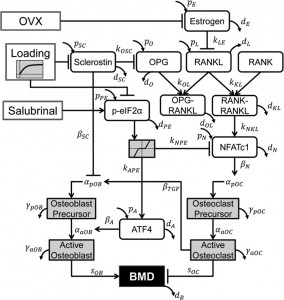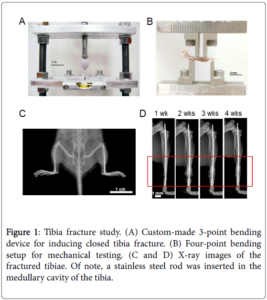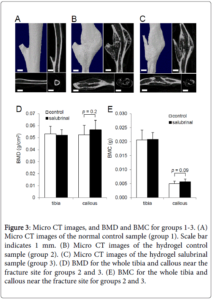The LSJL scientists Yokota and Zhang posted another LSJL related study. Not a lot can be gathered in relation to LSJL on height growth unless Nfatc1 or ATF4 can be found to be chondrogenic inducers or to increase peak chondrocyte hypertrophy.
Evaluating treatment of osteoporosis using particle swarm on a bone remodelling mathematical model.
“The model formulated a temporal BMD change of a mouse’s whole skeleton in response to ovariectomy, mechanical loading[LSJL] and administration of salubrinal.”<-So even though this study is studying mainly BMD we can extrapolate other LSJL effects via LSJL’s affect on gene expression and cells.
“The best treatment was found to start with mechanical loading followed by salubrinal.”
“Ovariectomy (OVX) was modelled through oestrogen deprivation, whereas salubrinal injection and knee loading were modelled by up-regulating p-eIF2α and inhibiting sclerostin, respectively.”<-In studying eif2a, it was unclear whether it could help increase height.
“To model the observed non-responsiveness to salubrinal at normal oestrogen levels in control mice, the model included a range of p-eIF2α values that does not elicit a change in ATF4 and NFATc1. When oestrogen levels decrease as in OVX mice, this range becomes
smaller, and ATF4 and NFATc1 become more responsive to changes in p-eIF2α.”<-ATF4 has some involvement in height but it doesn’t seem to be a powerful effector like say CNP.
This could connect to cartilage growth via NFATc1 or ATF4. NFATc’s do affect chondrogenesis.
“Knee loading was applied using a custom piezoelectric loading platform in the lateral-medial direction 3 min/day at 15 Hz, with a peak-to-peak force of 0.5 N”<-LSJL. Mice were 12 weeks old at time of treatment.
Hydrogel-Based Local Release of Salubrinal Stimulates Healing of Mouse Tibia Fracture
“Salubrinal is a synthetic compound (C21H17Cl3N4OS; 480 Da) which is known to reduce various cellular stresses including stress to the endoplasmic reticulum. It inhibits serine/threonine protein phosphatase 1 alpha (PP1), followed by the elevation of phosphorylated eukaryotic translation initiation factor 2 alpha (eIF2α). Salubrinal is reported to enhance bone formation by stimulating Activating Transcription Factor 4 (ATF4), one of the transcription factors for bone formation, via eIF2α-mediated signaling and stimulating development of bone-forming osteoblasts. It also suppresses nuclear factor of activated T-cells, cytoplasmic 1 (NFATc1), a master transcription factor for osteoclastogenesis, and inhibits development of bone-resorbing osteoclasts. It reduces inflammation and degradation of cartilage tissues{maybe it can delay growth plate cessation?}”
“C57BL/6 female mice (14 weeks, body weight ~20 g”
Here’s how the fracture was induced:
“salubrinal can add calcified mass to osteoporotic bone{maybe salubrinal encourages endochondral ossification}?”
In the stump on the left side the salubrinal group looks taller but less wide.
“salubrinal suppresses the proliferation and maturation of osteoclasts by downregulating AP-1 proteins such as c-Fos and JunB, as well as NFATc1”
Salubrinal improves mechanical properties of the femur in osteogenesis imperfecta mice.
“Salubrinal is an agent that reduces the stress to the endoplasmic reticulum by inhibiting de-phosphorylation of eukaryotic translation initiation factor 2 alpha (eIF2α). We and others have previously shown that the elevated phosphorylation of eIF2α stimulates bone formation and attenuates bone resorption. In this study, we applied salubrinal to a mouse model of osteogenesis imperfecta (Oim), and examined whether it would improve Oim’s mechanical property. We conducted in vitro experiments using RAW264.7 pre-osteoclasts and bone marrow derived cells (BMDCs), and performed in vivo administration of salubrinal to Oim (+/-) mice. The animal study included two control groups (wildtype and Oim placebo). The result revealed that salubrinal decreased expression of nuclear factor of activated T cells cytoplasmic 1 (NFATc1) and suppressed osteoclast maturation, and it stimulated mineralization of mesenchymal stem cells from BMDCs. Furthermore, daily injection of salubrinal at 2 mg/kg for 2 months made stiffness (N/mm) and elastic module (GPa) of the femur undistinguishable to those of the wildtype control. Collectively, this study supported salubrinal’s beneficial role to Oim’s femora. Unlike bisphosphonates, salubrinal stimulates bone formation. For juvenile OI patients who may favor strengthening bone without inactivating bone remodeling, salubrinal may present a novel therapeutic option.”
Salubrinal downregulated Nfatc1 in MSC like cells. If cells are less likely to become osteoclasts it is more likely more them to become cartilage.




Pingback: new study from LSJL authors | Natural Height Growth
Pingback: Sclerostin Inhibitors Promotes Bone Growth and Protects Against Cartilage Degradation - Natural Height Growth